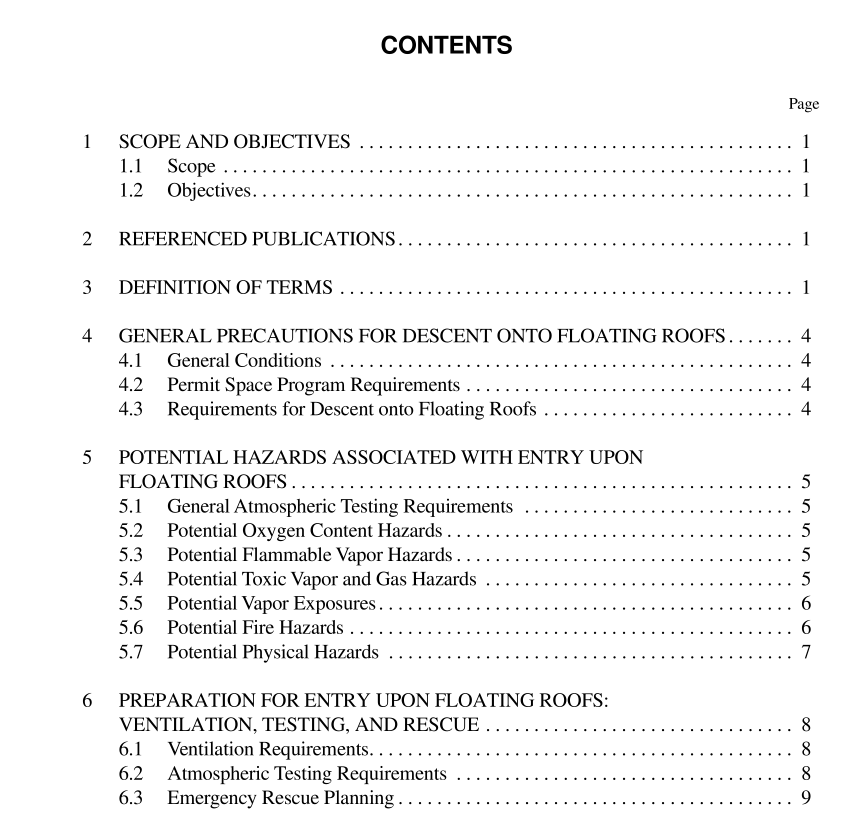API Publ 2026 pdf download

API Publ 2026 pdf download.Safe Access/Egress Involving Floating Roofs of Storage Tanks in Petroleum Service
1 Scope and Objectives
1.1 SCOPE
1.1.1 This publication addresses the hazards associated with access/egress onto open-top, covered open-top and inter- nal floating roofs of in-service petroleum storage tanks and identifies some of the most common practices and procedures for safely accomplishing this activity. 1.1.2 This publication is intended primarily for those per- sons who are required to perform inspection, service, mainte- nance or repair activities that involve descent onto floating roofs of in-service petroleum tanks. 1.1.3 This publication does not cover general consider- ations that apply to climbing onto petroleum storage tanks and other structures, including, but not limited to: (a) slippery or ice-covered stairways and walkways, (b) access during electri- cal storms, and (c) access during emergency conditions (such as to extinguish a fire or cover exposed product with foam). This publication may not apply to daily or routine tasks of tank gaugers and other personnel involved in non-permit con- fined spaces; however, such persons shall be trained and shall be made aware of the potential hazards described herein. 1.1.4 Preparations and precautions for entering petroleum storage tanks that have been removed from service for clean- ing are covered in API Standard 2015.
3 Definition of Terms
Terms that are used in this publication are defined in 3.1 through 3.17. 3.1 air-supplied respiratory protection: A respirator that provides a supply of safe breathing air from a tank (either a self-contained breathing apparatus portable tank or an air line supply tank) or from an uncontaminated fresh air supply source located outside of the work area. 3.2 cold work: Work activity that does not produce heat, sparks or other forms of energy sufficient to provide an ignition source if a vapor air mixture in the flammable range is present. 3.3 confined space (as defined by OSHA): A space that (a) is large enough and so configured that a worker can bodily enter and perform assigned work, (b) has limited or restricted means of entry or exit, and (c) is not designed for continuous occupancy by workers. a. Permit-required confined space, as defined by OSHA, is a space which meets the confined space requirements and also has one or more of the following characteristics: (1) contains or has the potential to contain a hazardous atmosphere, (2) contains a material with the potential to engulf an entrant, (3) has an internal configuration such that an entrant could become trapped or asphyxiated, or (4) contains any other rec- ognized serious safety or health hazard(s). b. Permit-required confined space program (Permit Space Program) is the facility’s (employer’s) overall program for controlling and regulating entry into permit-required confined spaces and, where appropriate, protecting employees from permit space hazards. c. Non-permit confined space means a confined space that does not contain or, with respect to atmospheric hazards, have the potential to contain any hazard capable of causing death or serious physical harm. 3.4 entry: Any work activity involving entry onto a float- ing roof. Entry occurs as soon as any part of an entrant’s body goes past the top of the tank preparatory to descent upon the floating roof. a. Attendant is a trained and qualified person stationed out- side a permit-required confined space to monitor the entrants and perform attendant duties in accordance with the facility’s Permit Space Program. b. Entrant is a person who is trained, qualified, and autho- rized to enter permit-required confined spaces. c. Entry supervisor is a person who by training and experi- ence is qualified and authorized to allow entry for work in permit-required and non-permit-required confined spaces and who is familiar with the tasks to be performed, the potential hazards that may be encountered in the confined space, the safety and health requirements for work in the confined space and the facility’s Permit Space Program . Designated Entry Supervisors are responsible to determine that acceptable per- mit-required confined space entry conditions are present and met; to authorize entry into permit and non-permit-required confined spaces; to assign or act as required testers, entrants, attendants and rescuers ; to oversee entry operations; and to terminate entry as required. d. Tester is a person who is trained and qualified to operate, calibrate and adjust instruments, and conduct appropriate atmospheric testing. When descending upon floating roofs to conduct testing, the tester then becomes an entrant . A tester or an entrant can also be an entry supervisor .









